

Advanced Distributed Learning. How do you capture the thought process of an expert gamer as they make their way through a game?
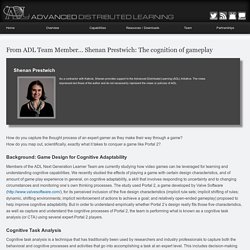
How do you map out, scientifically, exactly what it takes to conquer a game like Portal 2? Background: Game Design for Cognitive Adaptability Members of the ADL Next Generation Learner Team are currently studying how video games can be leveraged for learning and understanding cognitive capabilities. We recently studied the effects of playing a game with certain design characteristics, and of amount of game play experience in general, on cognitive adaptability, a skill that involves responding to uncertainty and to changing circumstances and monitoring one’s own thinking processes. Cognitive Task Analysis Cognitive task analysis is a technique that has traditionally been used by researchers and industry professionals to capture both the behavioral and cognitive processes and activities that go into accomplishing a task at an expert level.
Research-based principles for multimedia learning. Metalearning, The Four Hour Chef, and Instructional Design. Sharebar My ears perked up when I heard the word metalearning in an interview with the author of The Four Hour Chef, a new book by Tim Ferriss.
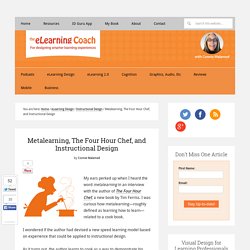
I was curious how metalearning—roughly defined as learning how to learn—related to a cook book. I wondered if the author had devised a new speed learning model based on experience that could be applied to instructional design. Brain-Based Learning: Resource Roundup. Facebook Edutopia on Facebook Twitter Edutopia on Twitter Google+ Pinterest Edutopia on Pinterest WHAT WORKS IN EDUCATION The George Lucas Educational Foundation Understanding How Brains Develop and Learn Five-Minute Film Festival: Learning and the Brain: Watch a collection of videos about the brain that will get you thinking about how findings from neuroscience can be applied in the classroom.
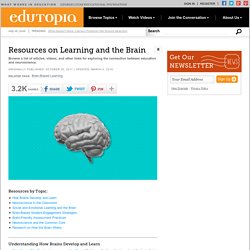
How Empathy Affects Learning, And How To Cultivate It In Your Students. A Neurologist Makes the Case for the Video Game Model as a Learning Tool. The popularity of video games is not the enemy of education, but rather a model for best teaching strategies.
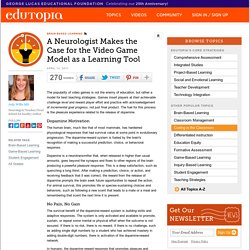
Games insert players at their achievable challenge level and reward player effort and practice with acknowledgement of incremental goal progress, not just final product. The fuel for this process is the pleasure experience related to the release of dopamine. Dopamine Motivation. The Bobo Beatdown - Crash Course Psychology #12. Educational technology’s next move: Tools to help kids learn with their bodies. Photo by Ryan Anson/AFP/Getty Images Today’s educational technology often presents itself as a radical departure from the tired practices of traditional instruction.

But in one way, at least, it faithfully follows the conventions of the chalk-and-blackboard era: EdTech addresses only the student’s head, leaving the rest of the body out. Treating mind and body as separate is an old and powerful idea in Western culture. Writing In The 21st Century. What are the arts but products of the human mind which resonate with our aesthetic and emotional faculties?
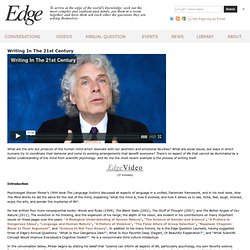
What are social issues, but ways in which humans try to coordinate their behavior and come to working arrangements that benefit everyone? Policy: Twenty tips for interpreting scientific claims. Science and policy have collided on contentious issues such as bee declines, nuclear power and the role of badgers in bovine tuberculosis.

Calls for the closer integration of science in political decision-making have been commonplace for decades. However, there are serious problems in the application of science to policy — from energy to health and environment to education. One suggestion to improve matters is to encourage more scientists to get involved in politics. Although laudable, it is unrealistic to expect substantially increased political involvement from scientists. Another proposal is to expand the role of chief scientific advisers1, increasing their number, availability and participation in political processes. Perhaps we could teach science to politicians? In this context, we suggest that the immediate priority is to improve policy-makers' understanding of the imperfect nature of science. European Journal of Open, Distance and E-Learning. Dorothy C.

Kropf [Dorothy.Kropf@waldenu.edu], Walden University, 100 Washington Avenue South, #900, Minneapolis, MN 55401, United States of America [ Transformed into a large collaborative learning environment, the Internet is comprised of information reservoirs namely, (a) online classrooms, (b) social networks, and (c) virtual reality or simulated communities, to expeditiously create, reproduce, share, and deliver information into the hands of educators and students. Most importantly, the Internet has become a focal point for a potentially dynamic modern learning theory called connectivism. There’s one key difference between kids who excel at math and those who don’t. “I’m just not a math person.”

We hear it all the time. Science: A New Map of the Human Brain. Stuart Firestein: The pursuit of ignorance. Stuart Firestein: The pursuit of ignorance. The 10 Minute Rule. So I ask this question in every college course I teach: “Given a class of medium interest, not too boring and not too exciting, when do you start glancing at the clock, wondering when the class will be over?”

There is always some nervous shuffling, a few smiles, then a lot of silence. Eventually someone blurts out: “Ten minutes, Dr. Medina.” “Why 10 minutes?” “That’s when I start to lose attention. Peer-reviewed studies confirm my informal inquiry: Before the first quarter-hour is over in a typical presentation, people usually have checked out. "10 Minute Rule" slide with audioTo learn more about how Brain Rules relates to presentations, check out Garr Reynolds's Brain Rules for Presenters slideshow. Phd.richardmillwood.net/en/theoretical-and-conceptual-framework/the-challenge-of-learning-theory.
Figure 5: Learning Theory. Adult Learning Methods and Technology. HILT 2013 Conference. Mind Brain Behavior Distinguished Lecture. Debunking the Genius Myth. Picture a “genius” — you’ll probably conjure an image of an Einstein-like character, an older man in a rumpled suit, disorganized and distracted even as he, almost accidentally, stumbles upon his next “big idea.” In truth, the acclaimed scientist actually said, “It’s not that I’m so smart, it’s just that I stay with problems longer.” Measuring User Engagement. Connectivism: A Learning Theory for the Digital Age. Connectivism: A Learning Theory for the Digital Age December 12, 2004 George Siemens Update (April 5, 2005): I've added a website to explore this concept at www.connectivism.ca Introduction.
Judy Willis on the Science of Learning. Awesome Chart on " Pedagogy Vs Andragogy " Adult learning is a vast area of educational research and probably one of the most complicated. Adults learn differently and have different strategies in learning. Adults Learning Theory and Principles explain in details these strategies and sheds more light on how adults cultivate knowledge. Talking about adult learning brings us to the concept of Andragogy. According to the article Malcolm Knowles an American practitioner and theorist of adult education, defined andragogy as “the art and science of helping adults learn”. A Visual Guide To Every Single Learning Theory. Learningtheories-full.jpg (1614×1145)